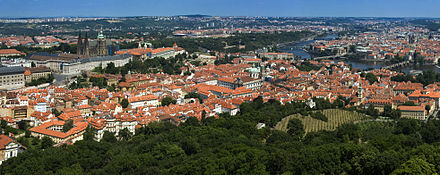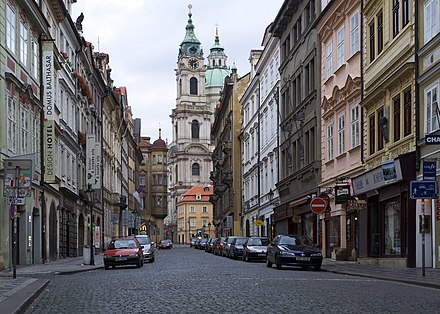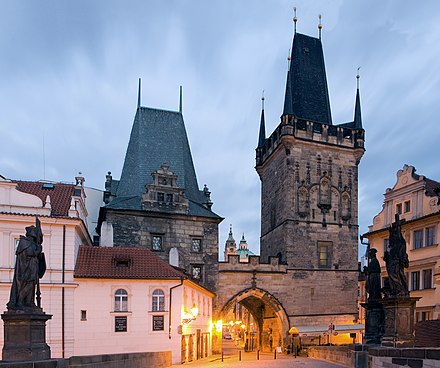
Malá Strana (Czech for "Little Side (of the River)", German: Prager Kleinseite) or historically Menší Město pražské (English: Lesser Town of Prague) is a district of the city of Prague, Czech Republic, and one of its most historic neighbourhoods.
In the Middle Ages, it was a dominant center of the ethnic German (and since 16th century also Italian) citizens of Prague.[citation needed] It also housed many noble palaces while the right-bank towns were comparatively more bourgeois and more Bohemian Czech.
The name Malá Strana literally means "Little Side", though it is frequently referred to as "Lesser Town", "Lesser Quarter", or "Lesser Side". It is on the left (west) bank of the river Vltava, on the slopes just below Prague Castle. The name distinguishes it from the larger districts of Prague on the right bank, with which it is linked by the Charles Bridge.
Originally, when it was founded in 1257, the district was called the New Town beneath Prague Castle (Czech: Nové Město pod Pražským hradem). When Charles IV founded the New Town of Prague in 1348, Malá Strana was renamed the Lesser Town of Prague (Czech: Menší Město pražské). In the 17th century, the unofficial name Little Quarter (Czech: Malá Strana) was used.[1]

Malá Strana was founded by the King Ottokar II of Bohemia in 1257.[1] As a royal town (a town founded by the king) it got many privileges. It was created by amalgamating a number of settlements beneath the Prague Castle into a single administrative unit. The original residents were expelled and mostly German craftsmen and merchants were invited by the king. Even though the city was royal, the king did not master the city as a whole.[citation needed]
In the second half of the 14th century the Lesser Town of Prague was extended by the King and Holy Roman Emperor Charles IV who built a new defensive wall called Hunger Wall.[1]
In 1419–1420 the Lesser Town was burnt down by Hussites. In 1541 the town was strongly damaged again by a fire which killed fifty people. After this fire the town was rebuilt in the Renaissance style and many palaces of nobility were built there.[1]
The market place, now known as Malostranské náměstí (Lesser Town Square),[2] was the center of the town. This square is divided into the upper and lower parts with the St. Nicholas Church in the middle.


Baroque architecture predominates in Malá Strana, but the history of the district dates back to far before the Baroque era. Baroque architecture eventually dominated when the style was implanted on Malá Strana after the destructive fires in 1541.
,_Vltava_River,_Prague,_2015.jpg/440px-Charles_Bridge_(Karlův_most),_Vltava_River,_Prague,_2015.jpg)
50°05′17″N 14°24′14″E / 50.08806°N 14.40389°E / 50.08806; 14.40389